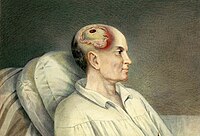
Photo from wikipedia
Study objective: Three clinical decision rules for head injuries in children (Pediatric Emergency Care Applied Research Network [PECARN], Canadian Assessment of Tomography for Childhood Head Injury [CATCH], and Children’s Head… Click to show full abstract
Study objective: Three clinical decision rules for head injuries in children (Pediatric Emergency Care Applied Research Network [PECARN], Canadian Assessment of Tomography for Childhood Head Injury [CATCH], and Children’s Head Injury Algorithm for the Prediction of Important Clinical Events [CHALICE]) have been shown to have high performance accuracy. The utility of any of these in a particular setting depends on preexisting clinician accuracy. We therefore assess the accuracy of clinician practice in detecting clinically important traumatic brain injury. Methods: This was a planned secondary analysis of a prospective observational study of children younger than 18 years with head injuries at 10 Australian and New Zealand centers. In a cohort of children with mild head injuries (Glasgow Coma Scale score 13 to 15, presenting in <24 hours) we assessed physician accuracy (computed tomography [CT] obtained in emergency departments [EDs]) for the standardized outcome of clinically important traumatic brain injury and compared this with the accuracy of PECARN, CATCH, and CHALICE. Results: Of 20,137 children, 18,913 had a mild head injury. Of these patients, 1,579 (8.3%) received a CT scan during the ED visit, 160 (0.8%) had clinically important traumatic brain injury, and 24 (0.1%) underwent neurosurgery. Clinician identification of clinically important traumatic brain injury based on CT performed had a sensitivity of 158 of 160, or 98.8% (95% confidence interval [CI] 95.6% to 99.8%) and a specificity of 17,332 of 18,753, or 92.4% (95% CI 92.0% to 92.8%). Sensitivity of PECARN for children younger than 2 years was 42 of 42 (100.0%; 95% CI 91.6% to 100.0%), and for those 2 years and older, it was 117 of 118 (99.2%; 95% CI 95.4% to 100.0%); for CATCH (high/medium risk), it was 147 of 160 (91.9%; 95% CI 86.5% to 95.6%); and for CHALICE, 148 of 160 (92.5%; 95% CI 87.3% to 96.1%). Conclusion: In a setting with high clinician accuracy and a low CT rate, PECARN, CATCH, or CHALICE clinical decision rules have limited potential to increase the accuracy of detecting clinically important traumatic brain injury and may increase the CT rate.
Journal Title: Annals of Emergency Medicine
Year Published: 2018
Link to full text (if available)
Share on Social Media: Sign Up to like & get
recommendations!